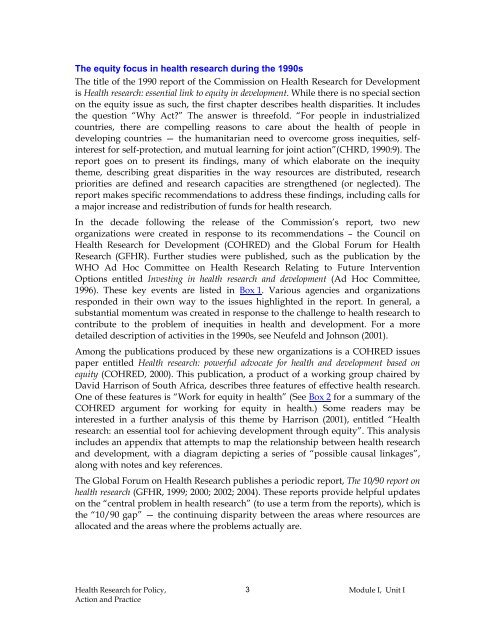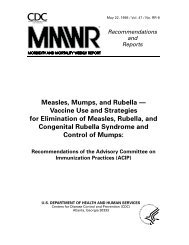Health Research for Policy, Action and Practice - The INCLEN Trust
Health Research for Policy, Action and Practice - The INCLEN Trust
Health Research for Policy, Action and Practice - The INCLEN Trust
- No tags were found...
Create successful ePaper yourself
Turn your PDF publications into a flip-book with our unique Google optimized e-Paper software.
<strong>The</strong> equity focus in health research during the 1990s<strong>The</strong> title of the 1990 report of the Commission on <strong>Health</strong> <strong>Research</strong> <strong>for</strong> Developmentis <strong>Health</strong> research: essential link to equity in development. While there is no special sectionon the equity issue as such, the first chapter describes health disparities. It includesthe question “Why Act?” <strong>The</strong> answer is threefold. “For people in industrializedcountries, there are compelling reasons to care about the health of people indeveloping countries — the humanitarian need to overcome gross inequities, selfinterest<strong>for</strong> self-protection, <strong>and</strong> mutual learning <strong>for</strong> joint action”(CHRD, 1990:9). <strong>The</strong>report goes on to present its findings, many of which elaborate on the inequitytheme, describing great disparities in the way resources are distributed, researchpriorities are defined <strong>and</strong> research capacities are strengthened (or neglected). <strong>The</strong>report makes specific recommendations to address these findings, including calls <strong>for</strong>a major increase <strong>and</strong> redistribution of funds <strong>for</strong> health research.In the decade following the release of the Commission’s report, two neworganizations were created in response to its recommendations – the Council on<strong>Health</strong> <strong>Research</strong> <strong>for</strong> Development (COHRED) <strong>and</strong> the Global Forum <strong>for</strong> <strong>Health</strong><strong>Research</strong> (GFHR). Further studies were published, such as the publication by theWHO Ad Hoc Committee on <strong>Health</strong> <strong>Research</strong> Relating to Future InterventionOptions entitled Investing in health research <strong>and</strong> development (Ad Hoc Committee,1996). <strong>The</strong>se key events are listed in Box 1. Various agencies <strong>and</strong> organizationsresponded in their own way to the issues highlighted in the report. In general, asubstantial momentum was created in response to the challenge to health research tocontribute to the problem of inequities in health <strong>and</strong> development. For a moredetailed description of activities in the 1990s, see Neufeld <strong>and</strong> Johnson (2001).Among the publications produced by these new organizations is a COHRED issuespaper entitled <strong>Health</strong> research: powerful advocate <strong>for</strong> health <strong>and</strong> development based onequity (COHRED, 2000). This publication, a product of a working group chaired byDavid Harrison of South Africa, describes three features of effective health research.One of these features is “Work <strong>for</strong> equity in health” (See Box 2 <strong>for</strong> a summary of theCOHRED argument <strong>for</strong> working <strong>for</strong> equity in health.) Some readers may beinterested in a further analysis of this theme by Harrison (2001), entitled “<strong>Health</strong>research: an essential tool <strong>for</strong> achieving development through equity”. This analysisincludes an appendix that attempts to map the relationship between health research<strong>and</strong> development, with a diagram depicting a series of “possible causal linkages”,along with notes <strong>and</strong> key references.<strong>The</strong> Global Forum on <strong>Health</strong> <strong>Research</strong> publishes a periodic report, <strong>The</strong> 10/90 report onhealth research (GFHR, 1999; 2000; 2002; 2004). <strong>The</strong>se reports provide helpful updateson the “central problem in health research” (to use a term from the reports), which isthe “10/90 gap” — the continuing disparity between the areas where resources areallocated <strong>and</strong> the areas where the problems actually are.<strong>Health</strong> <strong>Research</strong> <strong>for</strong> <strong>Policy</strong>,<strong>Action</strong> <strong>and</strong> <strong>Practice</strong>3Module I, Unit I
















